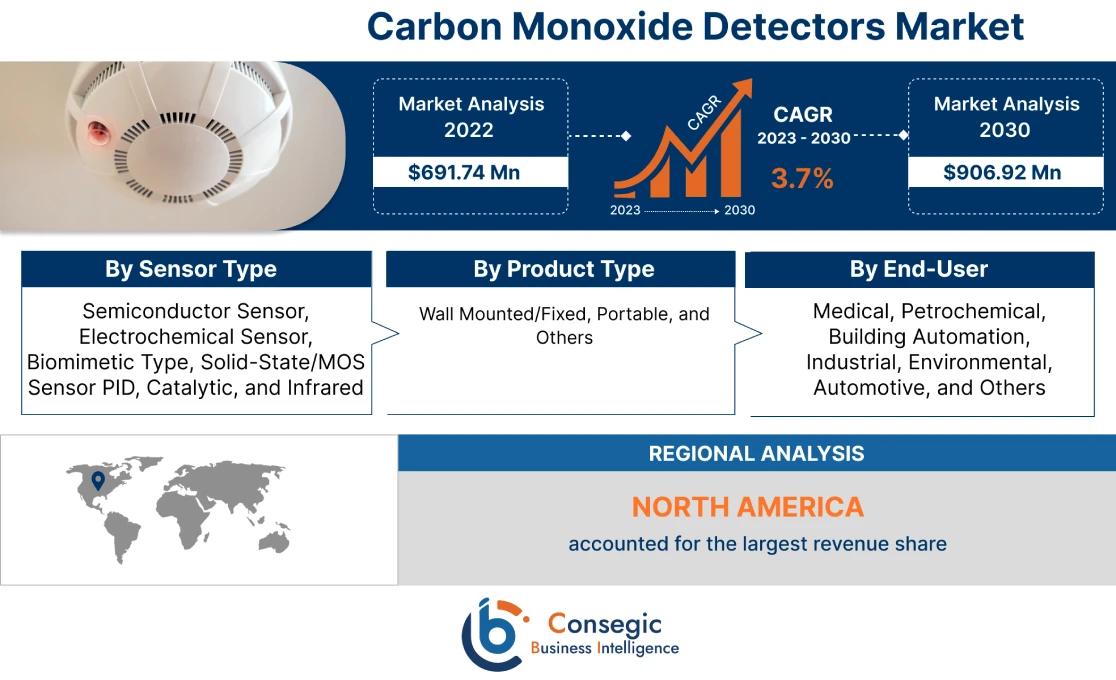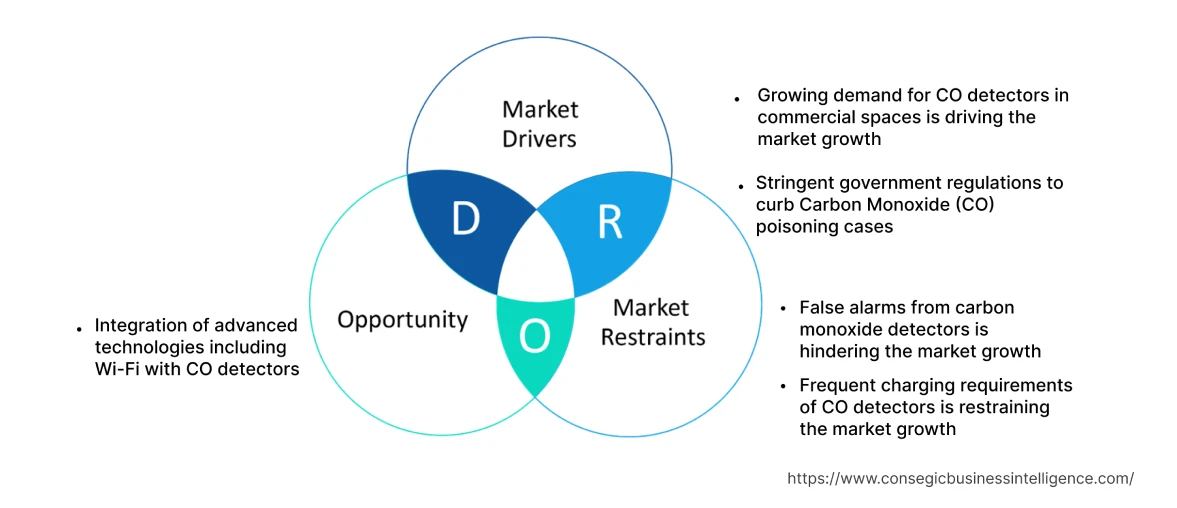Carbon Monoxide Detectors Market Introduction :
Carbon Monoxide Detectors Market size is estimated to reach over USD 906.92 Million by 2030 from a value of USD 691.74 Million in 2022, growing at a CAGR of 3.7% from 2023 to 2030.
Carbon Monoxide Detectors Market Definition & Overview:
Carbon monoxide or CO detectors are devices designed to measure the concentration of carbon monoxide in the air (in parts per million, or ppm). CO detectors have the ability to alert individuals to take appropriate measures due to the presence of carbon monoxide in the air. Carbon monoxide (CO) is an odorless and colorless gas which at high levels causes serious illness or other health issues. Consequently, CO alarms are designed to alert individuals about unusual build-up of CO in residential, commercial, and industrial spaces.
Carbon Monoxide Detectors Market Insights :
Carbon Monoxide Detectors Market Dynamics - (DRO) :
Key Drivers :
Growing demand for CO detectors in commercial spaces is driving the market growth
The growing adoption of Carbon Monoxide (CO) detectors in commercial spaces for the safety and security of the employees is driving the growth of the market. Commercial building with large areas requires carbon monoxide detection systems that are carefully designed and well-equipped to detect the presence of harmful CO present in the air. Carbon monoxide detectors are installed in stair towers, elevator shafts and ventilation shafts in offices and large commercial spaces to prevent CO toxicity. Therefore, the growing adoption of CO detectors in commercial spaces is propelling the growth of the market. For instance, in August 2022, Sense-secure collaborated with General Electric Research to develop carbon monoxide smart, wireless, CO sensor that has the ability to operate without any power source. Consequently, the rising need to maintain safety standards in commercial spaces is driving the growth of the market.
Stringent government regulations to curb Carbon Monoxide (CO) poisoning cases
The rising number of Carbon Monoxide (CO) poisoning cases worldwide is driving the demand for CO detectors in residential, commercial, and industrial spaces. The high levels of carbon monoxide occur from improperly installed, maintained or used fuel-burning appliances such as back-drafting appliances, fireplaces, or starting of cars in garages. Therefore, the government across several countries have mandated the installation of CO detectors, resulting in market growth. For instance, according to Centers of Disease Control and Prevention (CDC), approximately 420 people die from unintentional CO exposure in the United States every year. Therefore, government regulations to curb CO poisoning cases is accelerating the growth of the market.
Key Restraints :
False alarms from carbon monoxide detectors is hindering the market growth
CO detectors produce false alarms due to factors such as proximity to fuel-burning appliances, exposure to humidity, or the low quality of the device. Excessive moisture in the residential spaces causes CO detectors to produce false alarms. As a result, the limited adoption of CO detectors due to false alarms in homes, hospitals, colleges, and government agencies is hindering the growth of the market.
Frequent charging requirements of CO detectors is restraining the market growth
Carbon monoxide detectors are battery-powered and need to be charged once the battery is drained-off. As a result, CO detectors stop functioning and need to be charged again. Consequently, the high charging requirements of CO detectors limits their adoption in residential, industrial, and commercial spaces, thereby hindering the growth of the market.
Future Opportunities :
Integration of advanced technologies including Wi-Fi with CO detectors
The integration of advanced technologies such as Wi-Fi with CO detectors is anticipated to present potential opportunities for the growth of carbon monoxide detector market during the forecast period. The operation of CO detectors with Wi-Fi connectivity allows individuals to receive alerts via mobile notification. Moreover, the sensors in CO detectors provide voice alerts when CO is detected by the sensor. For instance, in January 2022, Kidde launched Smoke + Carbon Monoxide Alarm designed for Wi-Fi connectivity and smart features corresponding to the new mobile app. Thus, the ability of CO detectors to provide smart home features is expected to drive the market growth during the forecast period.
Carbon Monoxide Detectors Market Report Insights :
| Report Attributes | Report Details |
| Study Timeline | 2017-2030 |
| Market Size in 2030 | USD 906.92 Million |
| CAGR (2023-2030) | 3.7% |
| By Sensor Type | Semiconductor Sensor, Electrochemical Sensor, Biomimetic Type, Solid-State/MOS Sensor PID, Catalytic, and Infrared |
| By Product Type | Wall Mounted/Fixed, Portable, and Others |
| By End User | Medical, Petrochemical, Building Automation, Industrial, Environmental, Automotive, and Others |
| By Region | North America, Europe, Asia-Pacific, Latin America, Middle East & Africa |
| Key Players | ABB Ltd., Aeroqual Ltd., Alphasense, Dynament Ltd., First Alert, GfG Europe Ltd., Kidde, MTI Industries, Inc., NGK Insulators Ltd., Robert Bosch GmbH, Siemens AG, System Sensor |
Carbon Monoxide Detectors Market Segmental Analysis :
Based on the Sensor Type :
Based on the sensor type, the market is segregated into electrochemical sensor, semiconductor sensor, biomimetic type, solid-state/MOS sensor PID, catalytic, and infrared. The biomimetic segment accounted for the largest revenue share in the year 2022. Biomimetic type detector is a reliable technology and is widely deployed in large buildings such as hospitals, hotels, and apartments that use disinfectants, alcohols and air fresheners that release CO gas. The chemical called a chromophore present in the biomimetic CO detector reacts with CO present in air and changes the color of the chromophore. The color change is registered using light from an LED, thereby producing alerts on the presence of CO in air. Therefore, the application of biomimetic sensors in the aforementioned spaces is driving the growth of this segment.
The infrared segment is anticipated to emerge as the fastest-growing segment during the forecast period. Non-Dispersive type Infrared Absorption (NDIR) sensors are widely utilized for various types of gas detection such as carbon dioxide (CO2), carbon monoxide (CO), and hydrocarbons (HC). Infrared detectors consist of a light source, measurement chamber, interference filter, and IR detector. Infrared radiation is transferred through the gas and enters into the detector. Consequently, the detector provides alerts due to the presence of CO in the atmosphere. For instance, in December 2020, Crowcon launched MPS Gas Sensor in a fixed detector comprising of infrared (IR) sensor for detection of gases. As a result, the application of Infrared systems in industrial settings to provide advanced gas detection is driving the growth of the market.
Based on the Product Type :
Based on the product type, the market is separated into wall mounted/fixed, portable, and others. The wall-mounted segment accounted for the largest revenue share of 48.21% in the year 2022. A fixed CO detector is a device used to detect high concentrations of CO to warn the user of potential dangers. Detectors play a crucial role in monitoring areas where harmful gases are released on a regular basis. Additionally, fixed/wall mounted devices have the ability to activate other systems such as fire panels, ventilation systems or building management/security systems. Thus, the growing adoption of wall-mounted CO detectors in residential and commercial spaces is accelerating the growth of the market.
The portable segment is anticipated to witness the fastest CAGR growth during the forecast period. Portable CO detectors are essential for displaying the level of carbon monoxide instantly and accurately. Moreover, portable detectors have the ability to display the presence of CO in a room environment by means of a display screen, as compared to wall-mounted CO detectors that alarm only when elevated CO levels are detected by the sensor. For instance, in July 2020, American Honda Motor Co., Inc. introduced a new portable advanced carbon monoxide (CO) detection system called CO-MINDER, designed to protect individuals from injury or other health issues due to accidental carbon monoxide poisoning. Thus, the ability of portable detectors to monitor the indoor air for the presence of Carbon Monoxide (CO) gas is driving the growth of the market.
Based on the End-User :
Based on the end-user, the market is segregated into medical, petrochemical, building automation, industrial, environmental, automotive, and others. The industrial segment accounted for the largest revenue share in the year 2022. In manufacturing industries, carbon monoxide is released into the air. Carbon monoxide produced in large-scale industries due to the partial oxidation of hydrocarbon gases from natural gas or by the gasification of coal and coke. Therefore, the emission of carbon monoxide in air increases the demand for CO detection systems in industrial spaces. For instance, in May 2021, Industrial Scientific launched the Tango TX2, a new two-gas monitor that increases site safety by allowing users to detect carbon monoxide gas with one small and reliable monitor. Consequently, the adoption of carbon monoxide detectors in manufacturing plants and warehouses is accelerating the growth of the market.
The building automation segment is anticipated to register the fastest CAGR growth during the forecast period. The growing trend of smart home systems is driving the demand for advanced CO detectors in residential spaces. Consumers are increasingly adopting advanced security solutions such as CO detectors with enhanced connectivity options to monitor the presence of harmful gases in the atmosphere. Therefore, CO detectors are designed to provide notifications on unusual build-up of CO in homes. Consequently, the growing awareness among consumers about the health concerns associated with CO toxicity is proliferating the growth of the market.
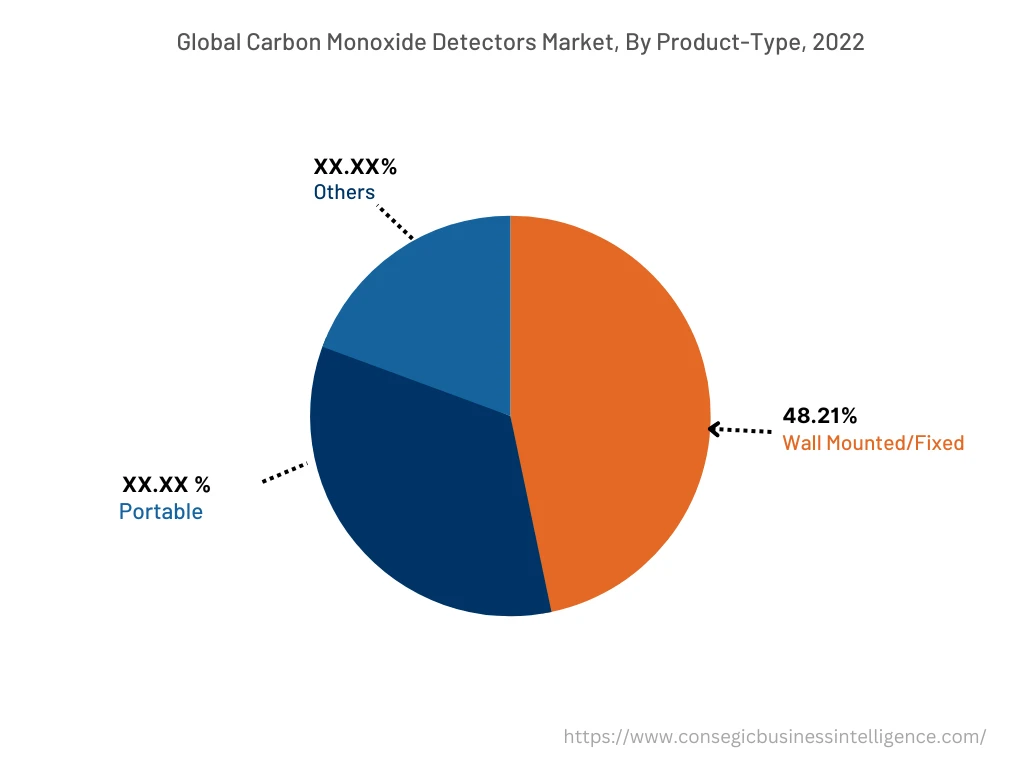
Based on the Region :
The regional segment includes North America, Europe, Asia Pacific, Middle East and Africa, and Latin America.
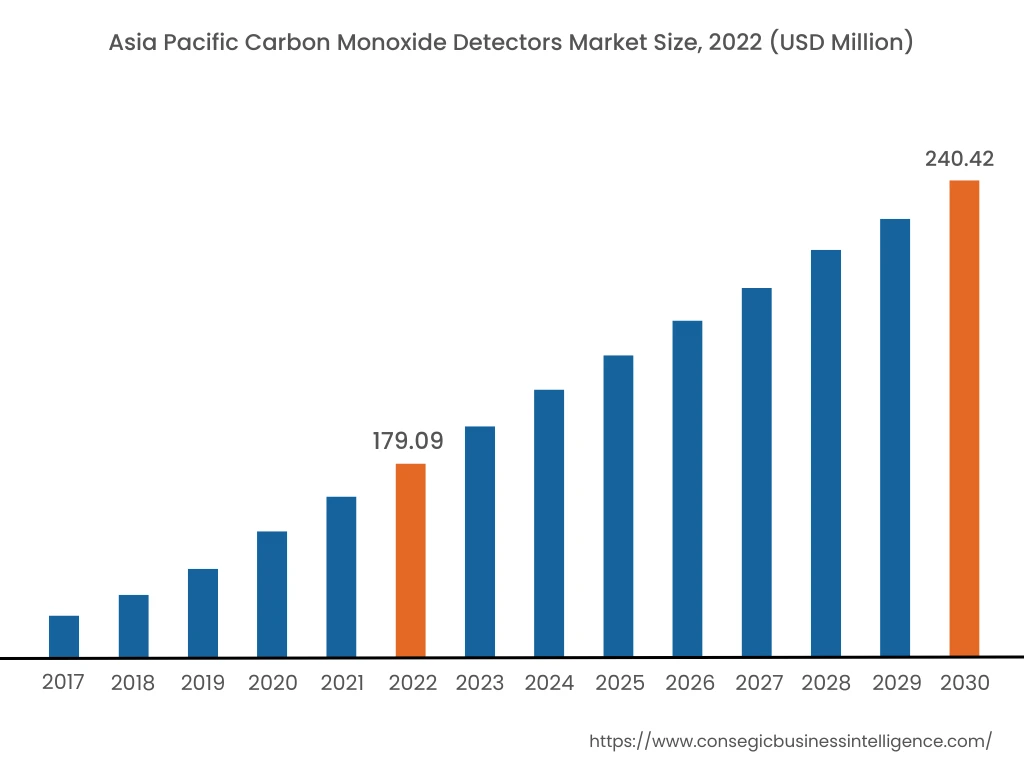
North America accounted for the largest revenue share in the year 2022. The rising cases of carbon monoxide poisoning in North America is driving the growth of carbon monoxide detectors market. The extreme cold climatic conditions in the region led to access accumulation of CO in the air due to the application of fuel-burning appliances including warm-air heaters in the region. For instance, according to Consumer Product Safety Commission, approximately 150 people in the United States die every year from accidental CO poisoning related to consumer products, including generators and warm air heaters. As a result, the rising need to install CO detectors to monitor the levels of CO in air is driving the growth of the regional market.
The Asia-Pacific region accounted for a revenue share of USD 179.09 million in 2022 and is expected to reach USD 240.42 million in 2030, registering a CAGR of 4.0% during the forecast period. Additionally, in the region, China accounted for the largest revenue share of 26.3% in the year 2022. The growing construction industry in Asia-Pacific is driving the demand in CO detectors in industrial spaces. The rising emission of CO in air due to the burning of fossil fuels is increasing the deployment of CO detectors to monitor the air quality. Moreover, the growing adoption of Carbon Monoxide (CO) in residential spaces is proliferating the growth of the market.
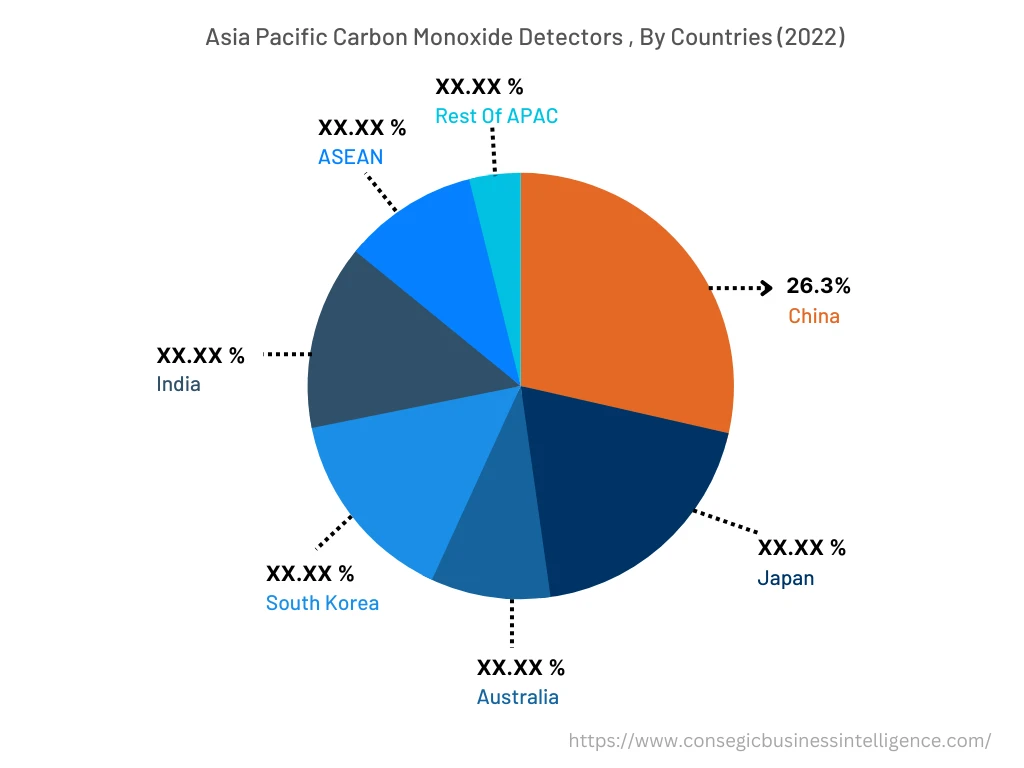
Top Key Players & Market Share Insights:
The carbon monoxide detectors market is characterized by the presence of major players providing CO detectors and alarms. Key players are various business strategies such as product innovation, research and development (R&D), and application launches have accelerated the growth of the Carbon Monoxide Detector market. Key players in the Carbon Monoxide Detector market include-
- ABB Ltd.
- Aeroqual Ltd.
- Siemens AG
- System Sensor
- Kidde
- MTI Industries, Inc.
- Alphasense
- Dynament Ltd.
- NGK Insulators Ltd.
- Robert Bosch GmbH
Recent Industry Developments :
- In September 2022, Blackline Safety Corp. launched G6 personal gas detector to alert workers to exposure of toxic gases, including Carbon Monoxide (CO) and Sulphur Dioxide (SO2).
- In January 2021, Ion Science India launched a wearable instrument that alerts workers on the exposure of gases including Hydrogen Sulphide (H2S), Carbon Monoxide (CO), and Sulphur Dioxide (SO2).
Key Questions Answered in the Report
What is Carbon Monoxide Detector? +
A carbon monoxide detector plays an important role in measuring the levels of CO in air. Carbon monoxide detector sound an alarm by detecting the levels of CO in atmosphere.
What specific segmentation details are covered in the carbon monoxide detector report, and how is the dominating segment impacting the market growth? +
By product type has witnessed wall mounted as the dominating segment in the year 2022, due to the ability of sensors to monitor high concentrations of CO.
What specific segmentation details are covered in the carbon monoxide detector market report, and how is the fastest segment anticipated to impact the market growth? +
By end-user segment has witnessed building automation as the fastest-growing segment during the forecast period due to the growing trend of smart home systems.
Which region/country is anticipated to witness the highest CAGR during the forecast period, 2023-2030? +
Asia-Pacific region is expected to register fastest CAGR growth during the forecast period due to increasing adoption of CO detectors in construction and manufacturing industry in the region.
